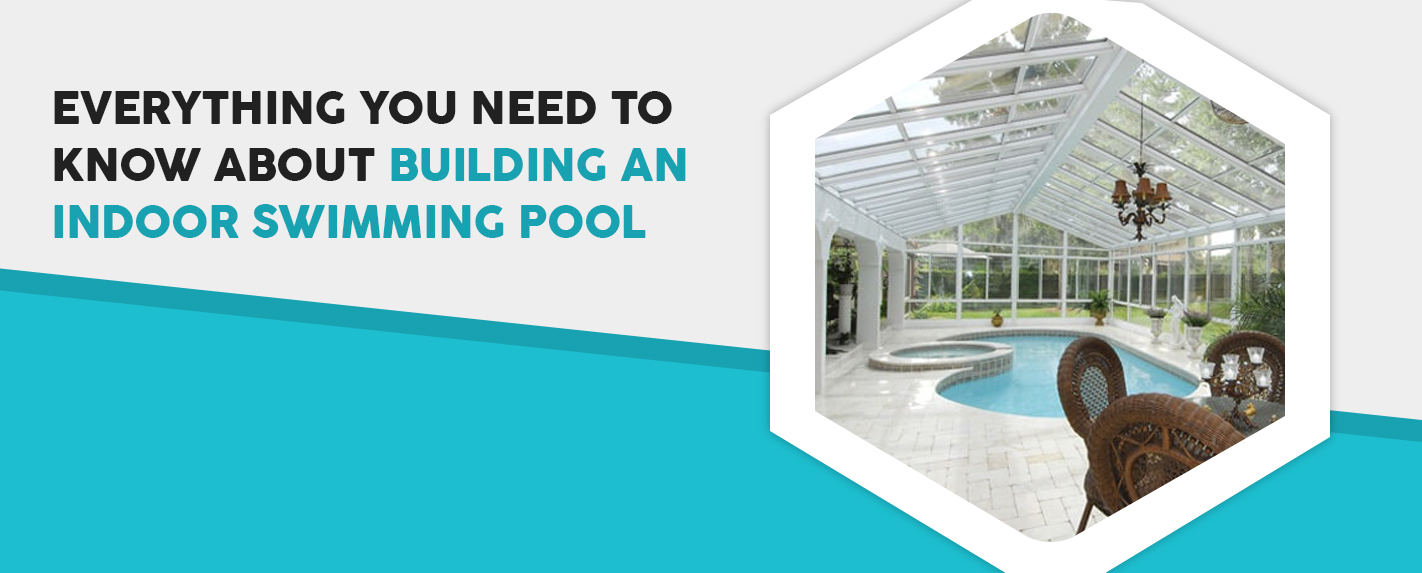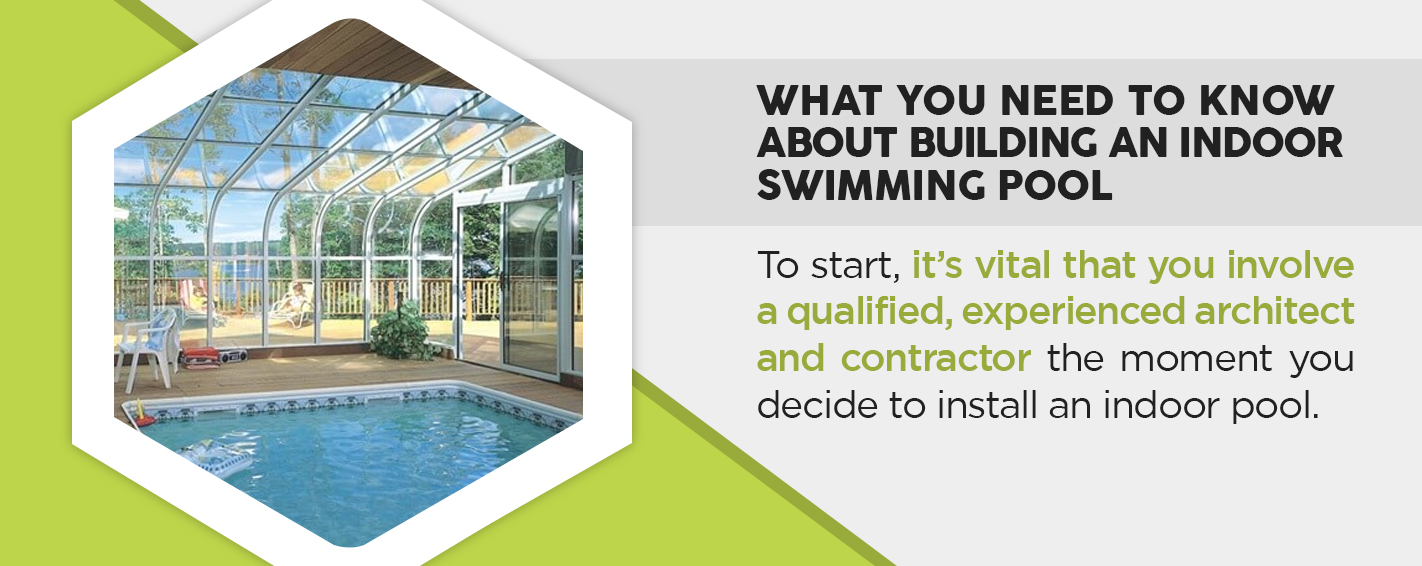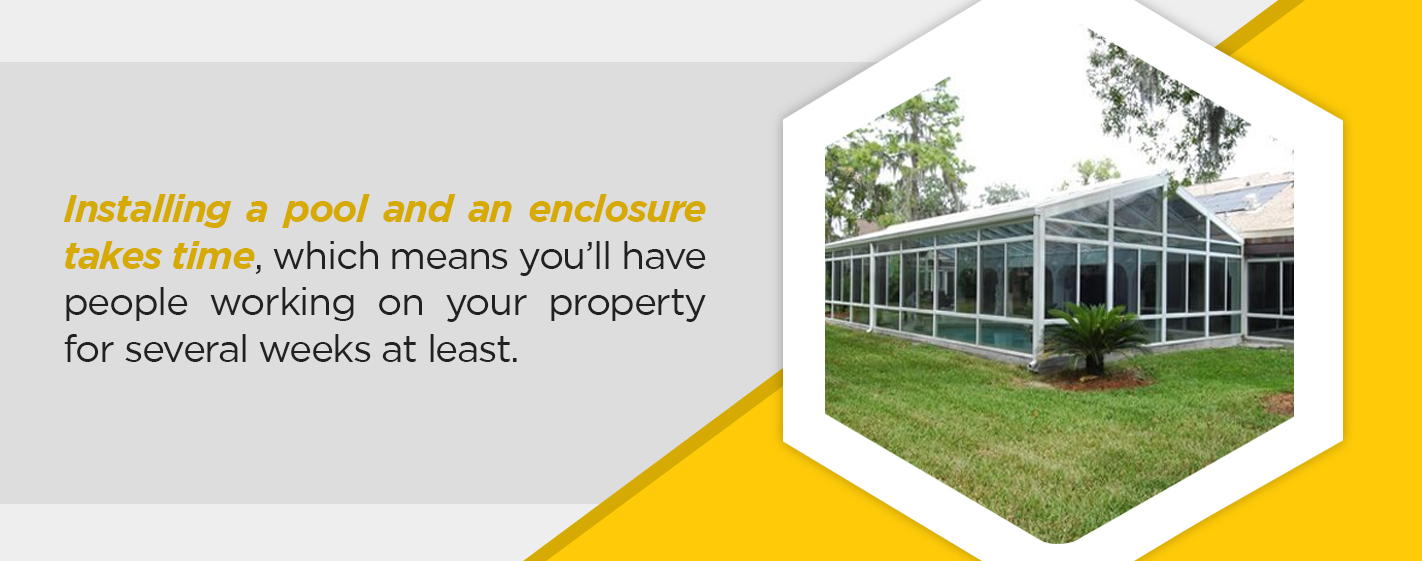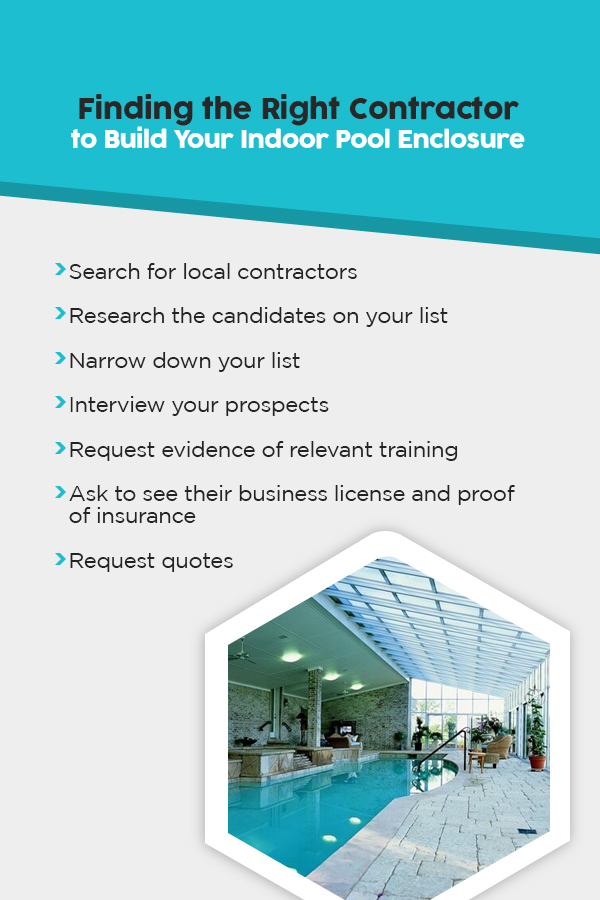Many Americans want their residence to have a pool. If you’re considering installing a pool at your home, one of your first choices is whether to build an indoor pool or an outdoor pool. While an outdoor pool may seem easier, the many advantages of an indoor swimming pool far outweigh any inconveniences. Whether you need indoor pool design ideas or want to know if a pool will add value to your home, this guide will explain what you need to know about indoor pools.
Benefits of Building an Indoor Swimming Pool
Homeowners with pools enjoy a wide variety of benefits. Having a place to relax, unwind and entertain is just one of the benefits that indoor and outdoor pools share. While there’s no doubt that having a pool is enjoyable, having a private indoor pool is even more advantageous than owning an outdoor pool.
Here are some of the benefits that accompany being the owner of an indoor swimming pool:
- Usable year-round: One of the biggest advantages to building an indoor pool is being able to use your pool every day of the year. Whether the sun is shining on a 90-degree day or the wind is blustering during a snowstorm, you can relax in your aquatic oasis year-round.
- Privacy: Although everybody is beautiful, some people are shy about jumping into a community pool or even one in their backyard because they feel vulnerable to onlookers. With indoor pools, those insecurities melt away because of the inherent privacy indoor swimming pools provide.
- Easy access: Because it’s part of your home, an indoor pool couldn’t be any easier to access. Rather than having to pack towels, snacks, sunscreen and drinks for yourself and the kids, you can simply roll out of bed and jump into your pool while still enjoying all the conveniences of being home.
- Temperature control: Most indoor pools have their own independent heating system, which enables you to control the temperature of the pool water. If you’ve ever jumped into a community pool only to regret it because the water was way too cold or an uncomfortable lukewarm, you understand the desire to be able to control the temperature of the water in a pool.
- Low maintenance: Outdoor swimming pools require a considerable amount of maintenance, such as removing debris and, depending on where you live, annual winterizing. While you still have to maintain an indoor pool, it requires significantly less effort and fewer resources since it’s protected by an enclosure.
- Physical health: Many people want a pool so they can work out in the water year-round. Swimming is a great full-body workout that can enable you to maintain your physique in the privacy of your own home. An indoor pool has even greater value for people who have disabilities and individuals recovering from joint replacement surgery. An indoor pool allows people who require physical therapy to engage in low-impact activities that can literally transform their lives and restore their physical and emotional well-being.
Learn More About Our Product Offerings
What You Need to Know About Building an Indoor Swimming Pool
If you’re considering building an indoor pool, you’re probably wondering what you need to know. As it turns out, you need to know a few key things. To start, it’s vital that you involve some who knows how to build an indoor pool the moment you decide to install an indoor one. Consulting with a qualified, experienced architect and contractor is advised. This is imperative for new construction as well as existing homes.
While it is possible to enclose a pool down the line, it’s best to decide if you want an indoor pool from the very start. Indoor and outdoor pools are largely built the same way, but there’s one meaningful difference between the builds — the slope of the deck. Outdoor pool decks are sloped away from the pool to prevent leaves and other debris from getting into the pool. Decks for indoor pools slope in the direction of the pool to stop water from reaching the walls of the enclosure.
When you build an indoor pool instead of an outdoor pool, you’ll have more materials to choose from because freezing and thawing won’t be relevant concerns. Indoor pools require their own heating, ventilation and air conditioning (HVAC) system no matter what materials you ultimately select for your pool and its enclosure. While your HVAC system should be sufficient to prevent the smell of chlorine from permeating throughout your home, you may want to consider adding an ozonator to your design before construction begins.
Remember –- having a pool will require you to dedicate more than enough room for your pool and deck area. You’ll also need an equipment room that has ample space for technicians to make repairs if they’re ever needed.
Things to Consider When Building an Indoor Swimming Pool
The biggest thing to consider when building an indoor pool is your budget. There isn’t much point to installing an indoor pool if you’re going to have buyer’s remorse every time you use it because you spent too much. One industry insider estimates that the cost of adding an indoor pool and an enclosure starts between $165,000 and $200,000.
While those figures may be intimidating, you shouldn’t abandon your dream of having an indoor swimming pool. Adding a pool to your home can add value to your property, meaning it may pay for itself when you sell your residence.
Although that may be all you need to know, there’s another crucial consideration that makes having an indoor swimming pool a worthwhile investment. And that’s all the precious memories you can make with your friends and family members in your pool area.
What’s Involved in Building an Indoor Pool
From a homeowner’s perspective, making decisions is your biggest responsibility when building an indoor swimming pool. For starters, you’ll have to choose the size of the pool you want. You’ll also need to select a practical location for your pool, whether that’s off your kitchen, master bedroom, living room or another space.
With your pool enclosure being an extension of your home, you’ll also have to decide how you want the enclosure to look. Do you want it to blend in seamlessly with your home’s overall aesthetic or do you want the enclosure to make its own statement? Are you going to use landscaping to disguise your enclosure or complement it?
Choosing the size and location of your pool and deciding how you want the enclosure to look are far from the only choices you’ll need to make. One of the most pressing decisions you’ll have to make is the type of pool you want to have. Will you have a saltwater pool or a pool that’s treated with chlorine?
In addition to making a lot of important decisions, you’ll also have to accept a few basic facts. Installing a pool and an enclosure takes time, which means you’ll have people working on your property for several weeks at least. The construction of your indoor swimming pool and enclosure can be thrown off by uncontrollable factors, such as the weather. Seeing the people working on your property as your partners in the construction of your own personal aquatic sanctuary will set a great tone for everyone involved in your project.
How Much Does It Cost to Heat an Indoor Swimming Pool?
It’s impossible to say how much it will cost to heat an indoor swimming pool definitively because the answer depends on factors that are unique to you, such as the energy costs in your area. While there is no blanket answer to the question of how much it will cost to heat an indoor pool, some universal practices are recommended to keep your pool heating costs within reason.
As a general rule, it’s wise to keep the water temperature at 78 degrees if you swim laps. If you use your indoor pool for recreational purposes, the temperature of the water should be maintained at 82 degrees. Turning up the temperature just one degree can increase your heating costs by as much as 10 percent.
If you’re not going to use your indoor swimming pool for three days or longer, you can cut your heating costs by turning off the heat and turning the thermostat back on at the desired temperature a few hours before you use your pool again. Alternatively, you can adjust the temperature to 60 degrees to prevent your heating system from working harder than necessary during times when you’re not using your pool. These tactics are advisable because reheating a pool consumes less energy than maintaining it at its original temperature.
Adding Home Value With an Indoor Swimming Pool
As we stated earlier, adding an indoor swimming pool may be an affordable way to increase the value of your home. Adding a pool might increase the value of a home by as much as 7 percent, which doesn’t include the added value a breathtaking enclosure has the potential to provide.
To determine whether building an indoor pool will add value to your home, you should look around your neighborhood. If your residence is the only one in the area that doesn’t have an indoor swimming pool, the absence of a pool may make it difficult to sell your home.
Homeowners who are wondering if adding an indoor swimming pool will increase the value of their residence are well-advised to hire an appraiser. Ask your appraiser to appraise the value of your home in its current state and to provide a separate appraisal as if a pool and an enclosure were already installed.
While the numbers tell part of the story, they won’t tell the whole tale. Like your home, the true value of an indoor pool rests in the quality of the time you’ll spend using your pool area with your loved ones. That time, coupled with the times when you’ll relax in your enclosed aquatic haven, makes an indoor swimming pool priceless.
Indoor Swimming Pool Design Ideas
If you’re going to have an indoor pool installed in your home, you’ll quickly realize there’s no shortage of pool design ideas. In fact, indoor swimming pool designs for homes are only limited by a person’s budget, imagination and physical space. Beyond those constraints, they’re virtually limitless.
Indoor swimming pool design ideas run the gamut from basic places to cool off to lush, lavish pool areas that occupy the entire floor of a house. Your indoor pool can even resemble a water park if you want it to.
When thinking about your pool in its finished state, the key is to think about the look, feel, function and all the amenities you want your indoor pool to have. Share your thoughts with your pool designer, knowing you can always cut back later if necessary.
Finding the Right Contractor to Build Your Indoor Pool Enclosure
Now that you know how to build an indoor swimming pool from the vantage point of a homeowner, it’s time to learn how you can find the right contractor to build your pool enclosure. Choosing the right contractor is as critical as coming up with a pool design you’ll love for years to come.
Here the steps to finding the right contractor to build your pool enclosure:
- Search for local contractors: If you’re not already familiar with the pool enclosure contractors in your area, search for some online. When you’re done, you should have a list that includes multiple contractors.
- Research the candidates on your list: You should research all the contractors on your list. Visiting each candidate’s website and going through their online reviews will enable you to learn a lot about each contractor.
- Narrow down your list: Based on your research, you can probably narrow down your list at this point. Contact the businesses that remain on your list, ask them for referrals you can talk to about their work and request a link to their portfolio of past work if one’s available online.
- Interview your prospects: After you’ve spoken to some former clients and you’ve reviewed their respective portfolios, you should arrange times to interview the prospects who are still on your list.
- Request evidence of relevant training: Installing pool enclosures requires technical expertise. When you interview contractors, ask them to provide proof that they have the training and experience necessary to install your pool enclosure.
- Ask to see their business license and proof of insurance: A reputable contractor will have a business license and the appropriate amount of liability and workers’ compensation insurance. Ask to see evidence of these things before you hire a pool enclosure contractor.
- Request quotes: Ask each contractor still on your list at this point for a detailed quote for your build. While the projected cost of your indoor pool enclosure is important, you need to consider all the information you learned during this entire process to pick the best contractor for your project.
Learn More About Our Product Offerings
Maryland Sunrooms, Your Indoor Pool Enclosure Builder
Proudly serving Baltimore and nearby communities, Maryland Sunrooms is the area’s top pool enclosure and installation company. With more than a century of combined experience, we’ve amassed an impressive portfolio of work that includes luxurious indoor pools in Maryland that are as gorgeous as they are practical year-round.
Whether you have an existing pool or you’re going to install one, we can design and build a pool enclosure that will wow you with its durability and beauty. We invite you to schedule a free design consultation with our pool enclosure design and installation experts now.

Julie Shetter is the Marketing Director at Maryland Sunrooms. She has over a decade of experience in the home improvement and sunroom industry.





